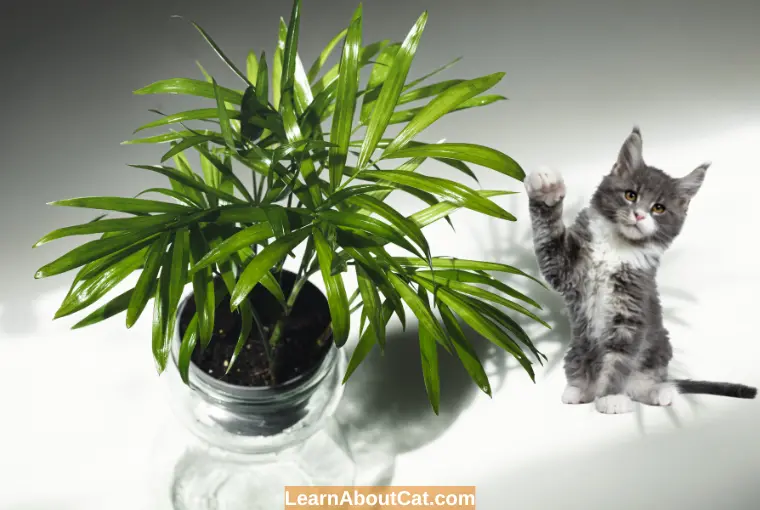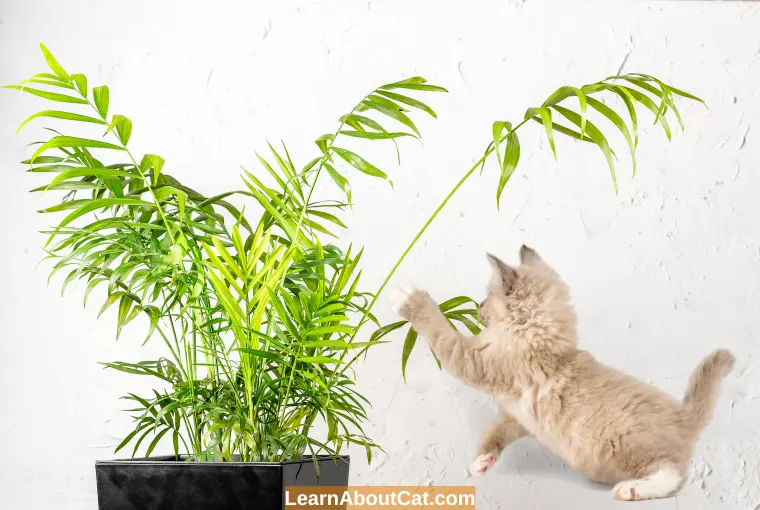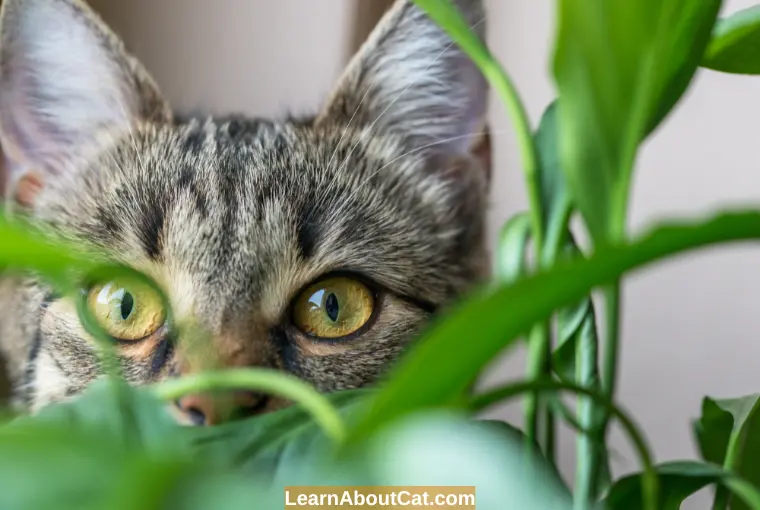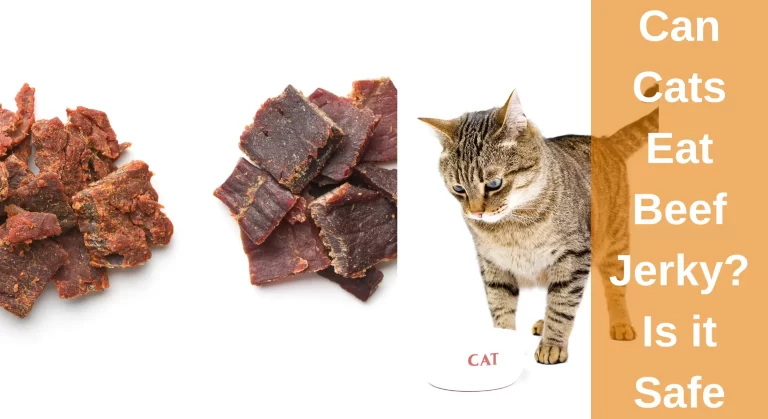Is Cat Palm Safe for Cats? [Answered]
Most of you love to keep a variety of popular plants, such as cat palms, in your home, but owners having cats must be cautious about these houseplants’ safety. Maybe your cat tries to play with your new palm plants and knocks them off. Moreover, most cat owners are concerned about what if their cat eats palm leaves. Is cat palm safe for cats?
Cat palms are non-toxic and don’t cause any adverse effects to your felines; This means that if you place them in an area where your pets can reach them, you don’t have to worry about their health.
Although they don’t pose any toxic effects, cat palms are vegetation; if your felines consume them in bulk, they may get gastrointestinal issues. Because cats are carnivores and they don’t eat much vegetation. So, if possible, keep your cat’s palms away from your pets.
If you own a cat, then choosing a plant needs extensive research because there’s no universal rule about which houseplants are safe. In today’s article, we’re going to discuss the safety of cat palms for felines because of the many cat owners’ requests we received regarding cat palm plants. So, continue to read this post to find more interesting facts about cat palms.

What is a Cat Palm?
Cat palm is the common name of a cat-friendly plant that is scientifically known as chamaedorea cataractarum, which belongs to the palm botanical family.
This plant is recognized by its lengthy, narrow leaflets. They’re mostly grown outside in perfect sunlight and bunched their stems in the form of bushes.
These plants can endure a variety of soil types as well as temperatures as cold as 30°F for a very short time. Cat palms can reach heights of up to 96 inches in an ideal environment.
It’s an ideal indoor plant as it doesn’t cause any harmful effects to your cats and dogs if they accidentally consume it.
Check Out: Can Cats Eat Sage?
Are Cat Palms Toxic to Cats?
A dense clumping palm known as Cat palm (Chamaedorea cataractarum) produces glossy, dark green leaves that make it a good specimen or hedge plant.
According to ASPCA and Missouri Botanical Garden, Cat palms are non-toxic to cats and dogs and do not pose any serious threat to their health.; Chamaedorea elegans, which belongs to the same genus as cat palm, is described as a popular houseplant and does not seem to pose any toxicity risks.

A substance known as calcium oxalate causes many popular houseplants to be toxic to cats and dogs, such as pothos, philodendrons, peace lily, monstera, elephant’s ear, and many more.
Plant foliage and stems contain calcium oxalate crystals, which can irritate any soft tissue they come into contact with, whether it’s your skin or your pets’.
Good news for pet owners; The cat palm does not contain calcium oxalate or any other toxic substances that are harmful to cats or dogs, making it an excellent plant for homes with pets.
Also, Check Out: Are Ferns Toxic to Cats?
Can Cats Eat Cat Palm Leaves?
Cats aren’t poisoned by cat palms such as chamaedorea cataractarum. However, consuming cat palms in bulk amounts will result in digestive issues like gastrointestinal symptoms.
Moreover, in rare cases, persistent nausea, an absence of hunger, or tiredness, non-digestible substances like greens can cause a blockage in your feline’s gastrointestinal system.

However, it’s crucial to check that your living area vegetation is safe for felines if you have any. Some plants are poisonous to animals, such as the cycad palm family, which is the most dangerous palm plant for cats because it contains neurotoxins that harm their health.
Find Out: Is Peperomia Toxic To Cats?
What Happens If a Cat Eats Cat Palm?
Cat palms themselves do not pose any inherent threat to cats, but they can have slightly adverse effects on your pets because of pesticides that are sprayed on them, bugs that may live inside, and dust and dirt that accumulate.
How to Keep Cat Palm Away From Cats?
There are a few tips and tricks you can use to make your life easier when it comes to keeping your houseplants safe from cats and dogs.
- Spray lemon water on cat palms: The aroma of citrus is very unpleasant to dogs and cats. They will avoid it at all costs, including your cat palm plant.
- Surround the cat palm plant with lemon peels: Lemon peels are also an effective way to use citrus, as they have the same effect as spraying your plants with lemon water.
- Make sure that your cat palm plant is located in an area that is hard to reach: It will be best to place your cat palms on surfaces that are high above the ground since your pets won’t be able to reach them.
- Pets should not be allowed in the room where your plants are: If you have a separate room dedicated to your plants, this strategy is better than most people’s living rooms since most people put their houseplants in the living room.
Do Cat Palms have any Benefits?
Yes, cat palms offer a variety of benefits, including:
- Its design is easy to maintain and appealing compared to other indoor plants.
- Demand low light
- Don’t require any maintenance.
- Need less potting medium
- Grow quickly as compared to other palm plants.
Also, cat palms are reputed to be excellent for maintaining fresh air inside your home as well!
Also, Read: Are Snake Plants Toxic to Cats?
Are All Palms Safe for Cats?
Yes, a few true palm varieties are safe for cats. But it’s critical to realize how identical palm plants appear to one another. Other kinds of palm trees, such as the cycad palm species, are poisonous to cats.
If your feline accidentally eats this poisonous palm, you must watch out for signs of toxicity and pay attention to any serious severe effects that your feline may show.

Cycad Palms
The poisonous cycad palm family comprises a single, slowly expanding stem and palm-like leaves that branch widely. In contrast to the cat palm, the cycad plant has rigid greenery that “feels stiff like chipboard”.
In contrast, the cat palm’s leaflets are referred to as “soft.” The popular names of the cycad family include sago palm, cardboard, or ferns palm plants.
Signs and Symptoms of Cycad Palm Poisoning in Cats
The stems, leaves, and every part of cycad palm are poisonous for cats as it contains neurotoxins carcinogen, BMAA, and an undiscovered neurotoxic. One or two seedlings consumed can be lethal. The following are symptoms of cycad toxicity:
- Blood in vomiting
- Dark faeces
- Yellow lips and eyes (jaundice)
- Extreme thirst
- Bloody stools
- Blisters
- Liver problems
Without medical attention, cycad palm intake can cause death within a short time. The earlier your feline receives medical attention, the healthier it’ll become.
Other Cat-Safe House Plants?
A variety of other house plants are safe for cats and make your garden a safe place for your pet.

- Spider plants
- African violets plant
- Areca plants
- Calathea family plants
- Haworthia family plants
- Boston plants
- Orchids
Though plants aren’t poisonous to cats, it is nevertheless possible to disturb your cat’s stomach by eating too much of them.
Frequently Asked Question
Is cat palm pet friendly?
Yes! Cat palms are safe for your cats and dogs as well. Because they don’t contain any harmful substances or toxins. But as you know, excess of everything is bad, so if your pets consume it in a large amount, they may face GI tract problems.
Do cat palms clean the air?
Cat palms are effective air cleaners. These palms organically clean the air within your house by eliminating harmful volatile compounds like CO2. Moreover, if they’re placed near a cat litter box, they’ll also reduce the smell of cat litter.
What palms are non-toxic to cats and dogs?
A large portion of true palm plants you can grow at home are totally safe for pets; here are some of them:
Areca palm
Parlor palm
Ponytail palm
Majestic palm
Cascade palm
What palms are toxic to cats?
Although most palms you can grow at home are non-toxic to cats and dogs. But sago palm is a highly toxic palm that you should avoid growing at home at all costs.
This plant contains a substance known as cycasin, which can lead to weakness, drooling, vomiting, diarrhoea, tremors, and seizures.
Final Thoughts!
Even if your felines are entirely safe near cat palms, we always advise doing your best to keep them far from your plantings.
Since pets like cats love to nibble on houseplants, the wisest choice you can make to protect your cats and palms is to place them in places where they’re hard to reach by your cats.
Finally, because it’s hard to predict which houseplant can be harmful to your cat’s health, we strongly advise doing considerable study before purchasing any houseplant.
Related Posts:
Who is Isabella?
My name is Isabella, and I am a dedicated and knowledgeable cat enthusiast. With years of experience caring for cats and a deep love for felines, I made a mission to help other cat lovers navigate the challenges of cat ownership.






